Featured Comment
“This recipe is easy to make and delicious, thank you so much ❤”
– @crypticlolita (from YouTube)
Did you know the secret to restaurant-quality mentaiko pasta isn’t complicated technique, but rather it’s all in how you combine your ingredients?
It sounds gourmet, but it’s surprisingly achievable and will be ready in the time it takes to boil a pot of spaghetti.
Maybe you’ve been reluctant to use mentaiko because it feels intimidating, but I’ll walk you through it step-by-step with simple techniques and make sure your dish always tastes luxurious.
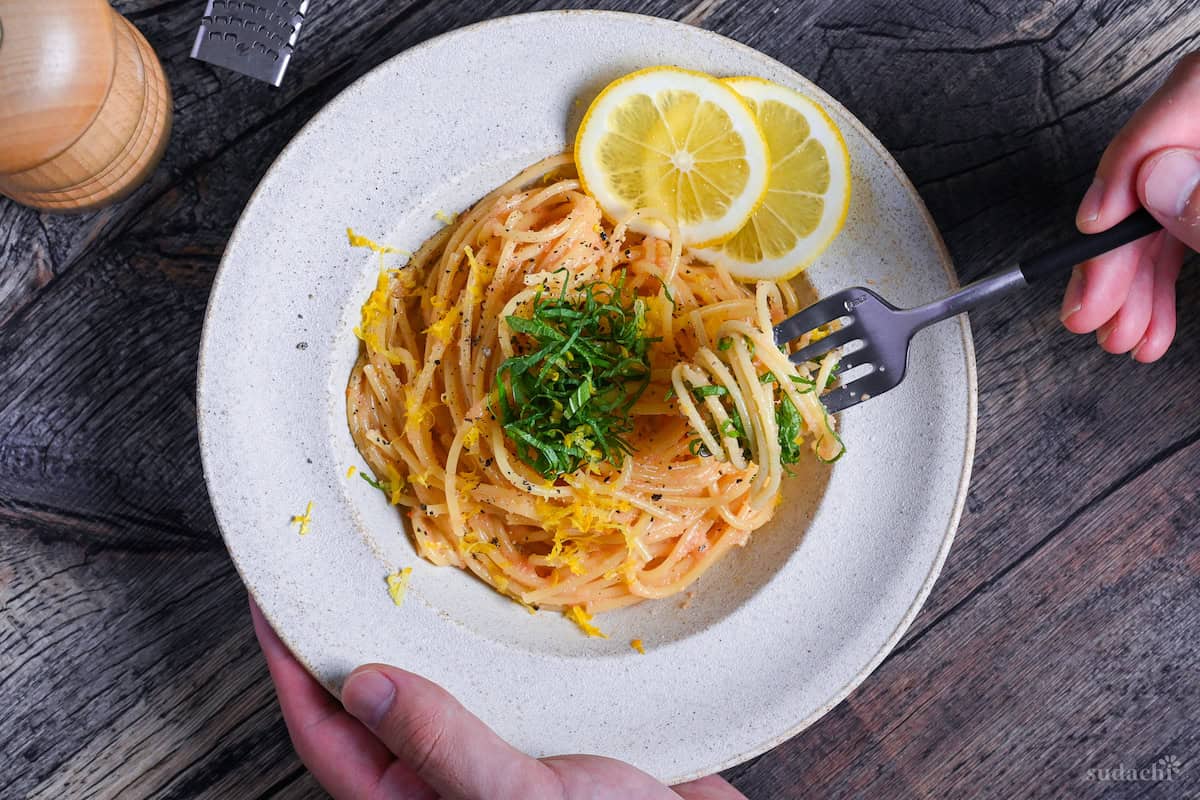
By the end, you’ll feel confident enough to proudly showcase your creation on social media or even at your next dinner party.
What is Mentaiko Pasta?
Mentaiko pasta is a tasty mix of Italian and Japanese, with a Korean influence (mentaiko actually has Korean roots). The spaghetti is cooked just right and tossed in a smooth sauce made from spicy cod roe, creating a surprising but perfect blend of three different cultures.
First served in a Tokyo pasta shop during the vibrant 1960s, the chef swapped expensive caviar for mentaiko to create an accessible yet gourmet experience.
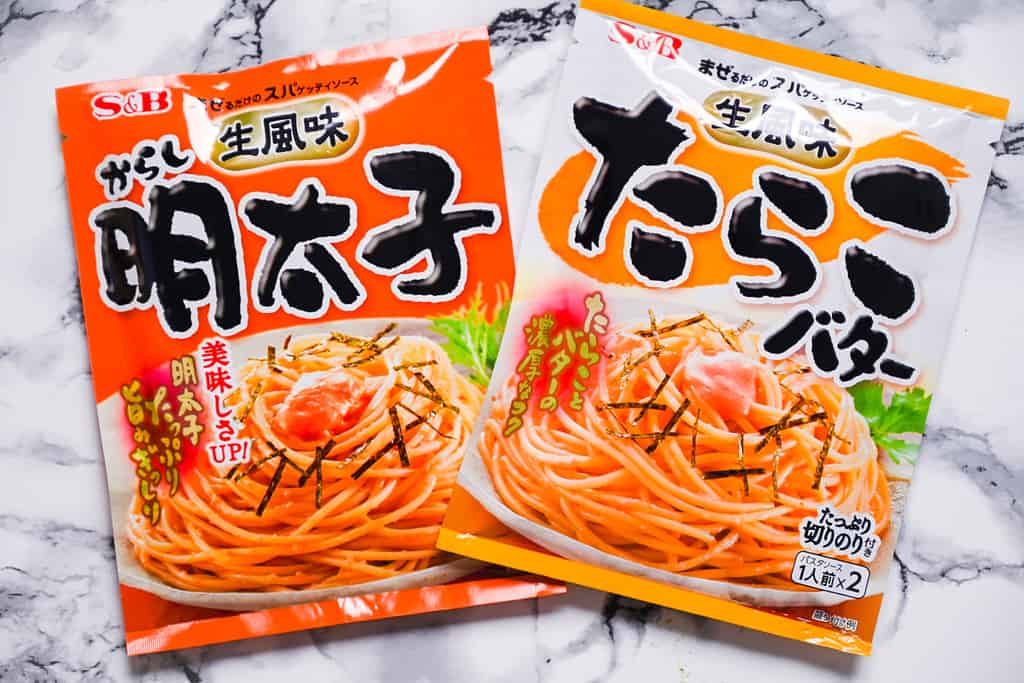
Today’s home cooks embrace it because it delivers restaurant-quality satisfaction in minutes, making it the perfect weeknight dish for busy professionals and families.
Key Ingredients & Substitution Ideas
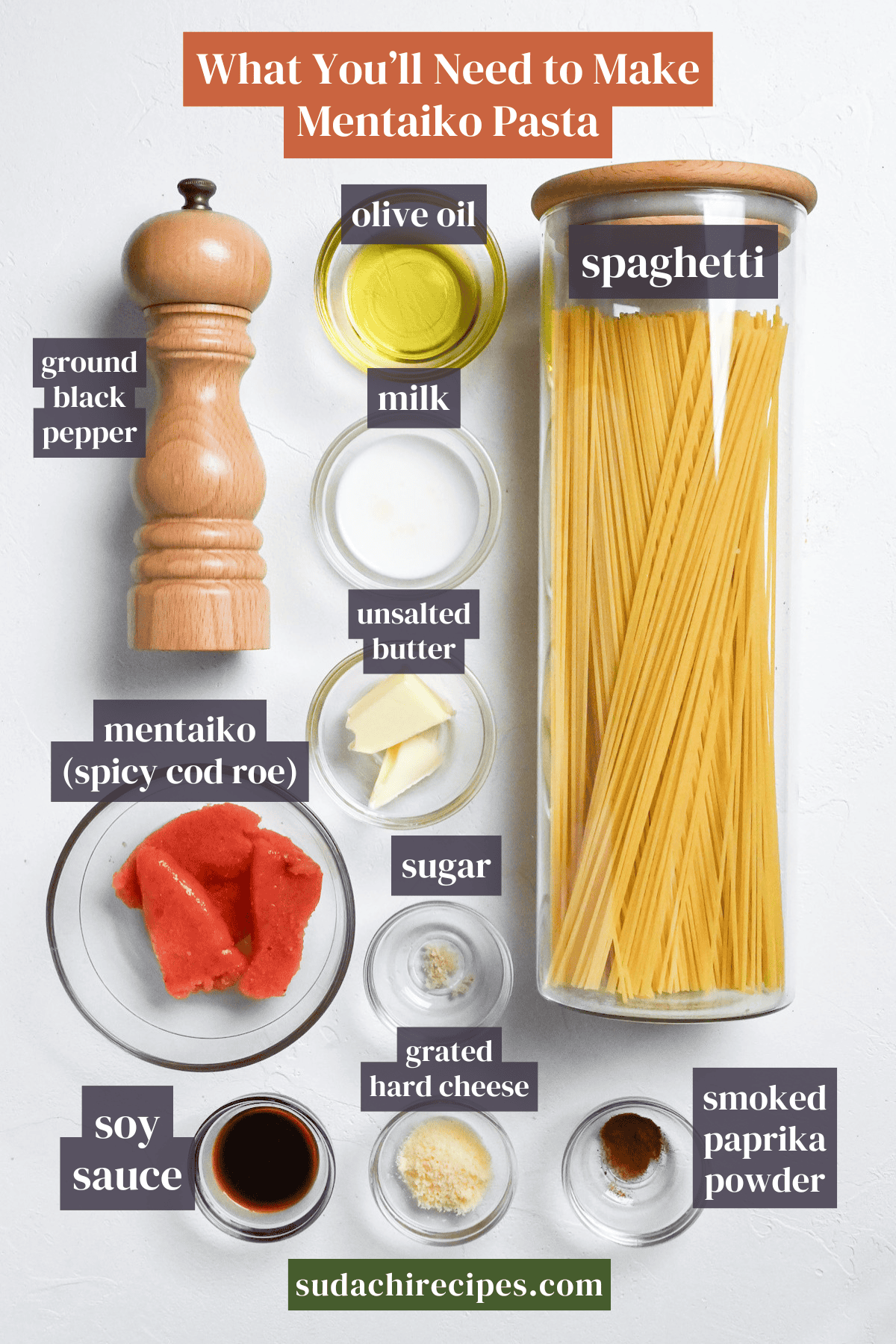
- Mentaiko (Spicy Cod Roe): It is pollock roe cured in salt and marinated with a blend of chili and seasonings. If you’re sensitive to heat or can’t find mentaiko, regular tarako (plain salted cod roe) works beautifully as a milder alternative. Look for mentaiko in the refrigerated section of Asian markets.
- Butter: This is essential in mentaiko pasta as it carries flavors, balances the spice, and creates a luxuriously creamy texture through emulsification. I strongly recommend against substitutions here since butter’s unique dairy compounds create the creamy texture and mellow sweetness that define this dish.
- Dry Spaghetti: Choose spaghetti with a thickness of 1.6-1.8mm for the best results, as this diameter perfectly catches the mentaiko pearls while allowing the sauce to coat each strand evenly.
- Smoked Paprika Powder: This is my secret ingredient, adding subtle sweetness and an enticing smoky note. If you don’t have it on hand, feel free to omit it.
Visual Walkthrough & Tips
Here are my step-by-step instructions for how to make Mentaiko Pasta at home. For ingredient quantities and simplified instructions, scroll down for the Printable Recipe Card below.
This section aims to provide a comprehensive overview of the cooking steps and techniques with visuals. It also includes more in-depth tips and tricks and explains why I do what I do.
Bring water to a rolling boil in a large pot, then add salt. Toss in your spaghetti, cooking until it’s just shy of al dente (about 30 seconds to 1 minute less than the package directions is recommended).
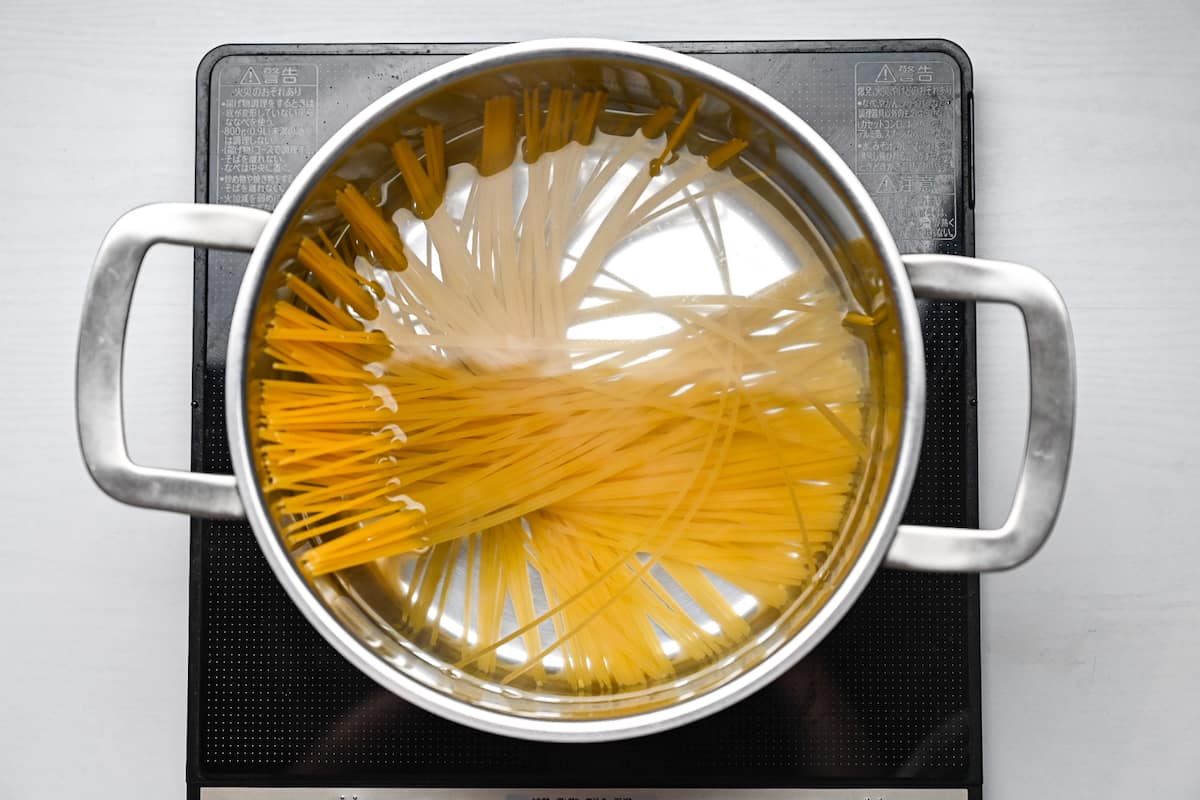
If you use a little less water than usual (about 1 liter for 100 grams of pasta instead of the usual 1.5 liters), you’ll get a more concentrated cooking liquid with more starch. This starchy water is what makes that restaurant-quality emulsified sauce that clings to each strand.
Take the spicy cod roe (mentaiko) and carefully slice open the thin membrane. Scoop out the tiny eggs gently with a spoon. Don’t worry if it gets a little messy.
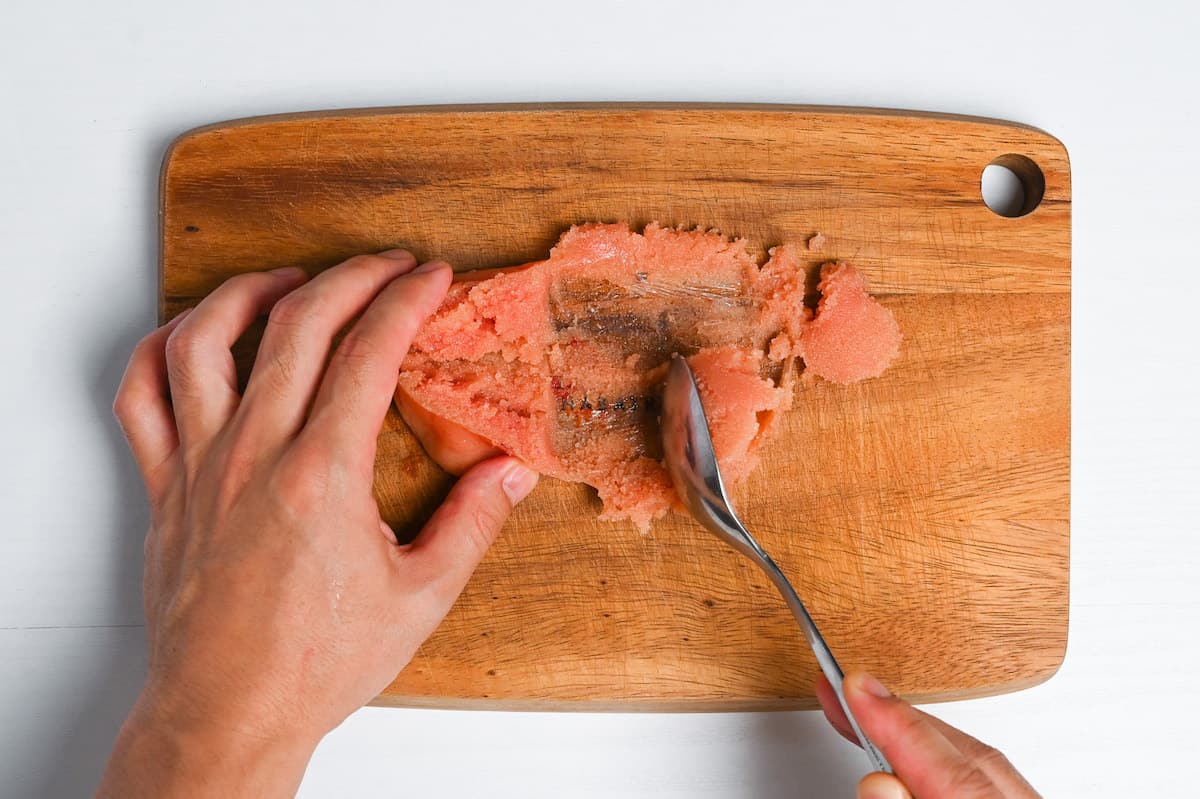
I usually eat the membrane as a snack while cooking, but it’s also great with rice or even as a rice ball filling!
In a large mixing bowl, combine the mentaiko with butter (room temperature), olive oil, soy sauce, sugar, ground black pepper, milk, grated Parmesan cheese, and smoked paprika.
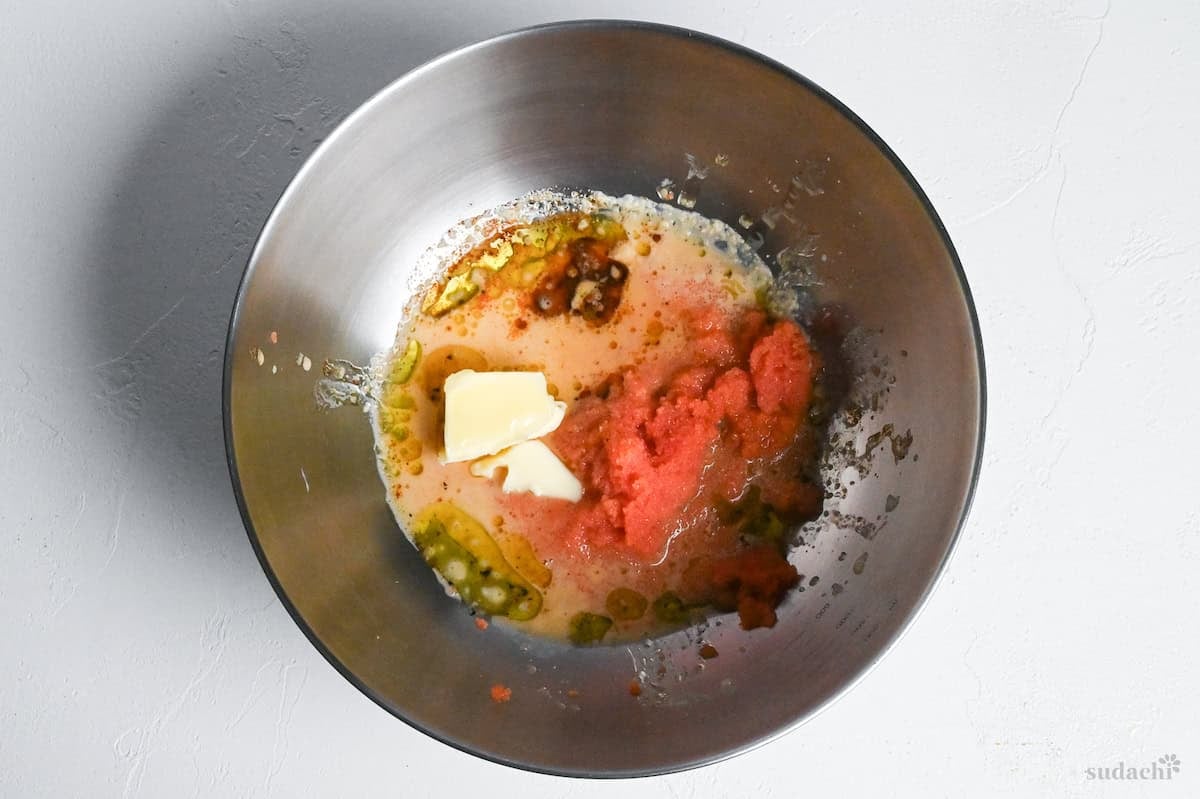
Add 1 tablespoon of the pasta cooking water and mix everything together until well combined.
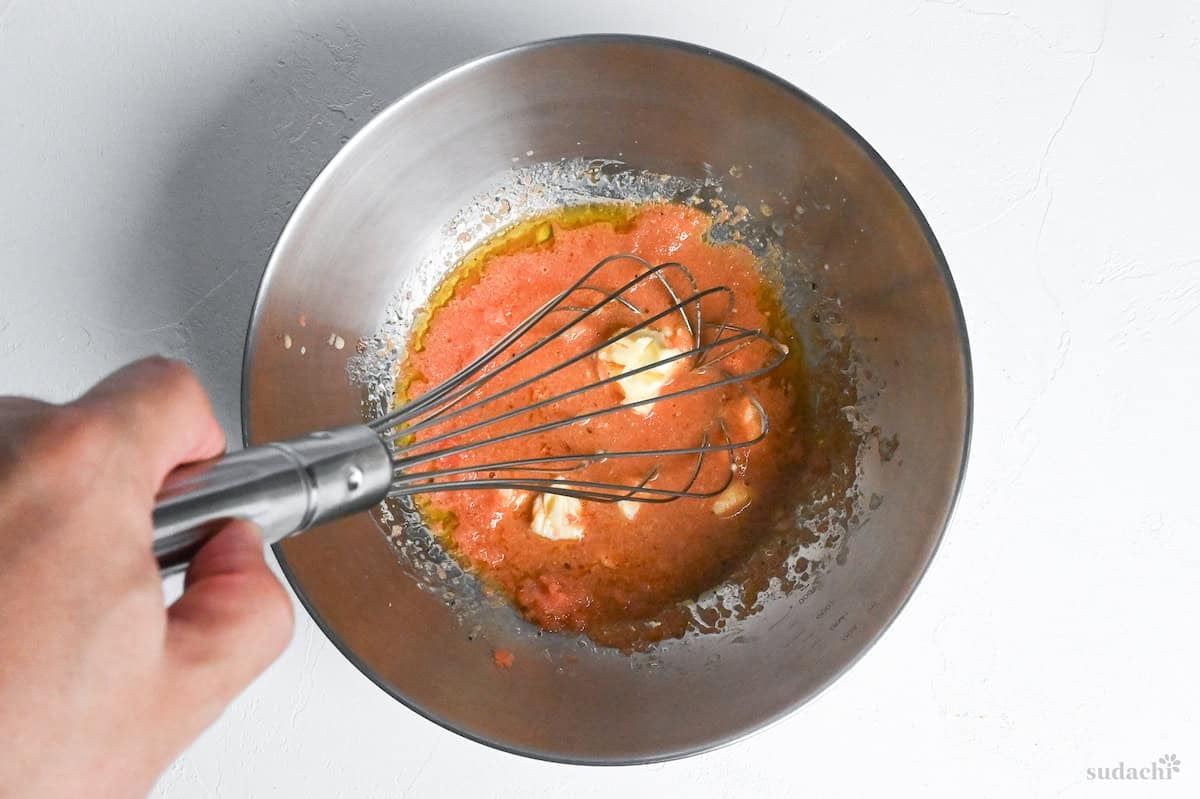
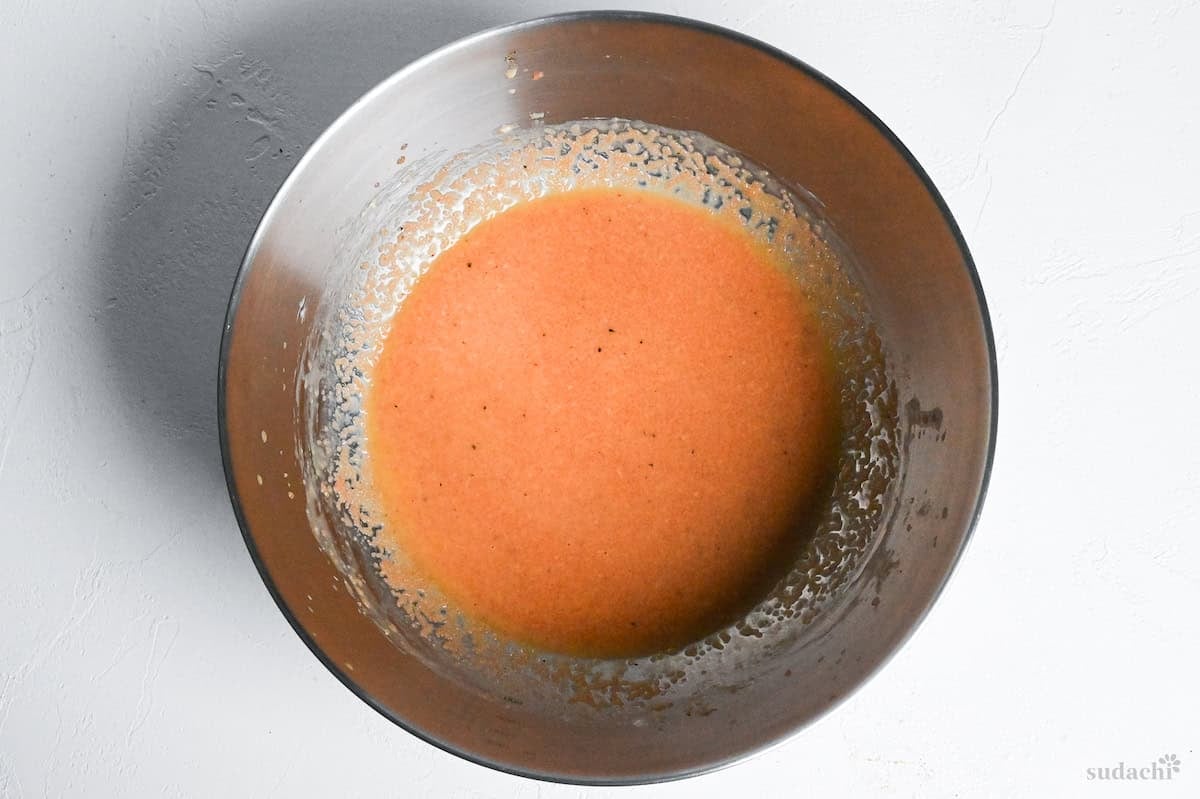
The hot pasta water melts the butter, which acts as both a flavor enhancer and an emulsifier, creating that creamy coating that makes the sauce cling to the pasta.
Once your pasta is almost ready, add another tablespoon of pasta water to your sauce base and whisk vigorously again. Then drain the cooked spaghetti (remember to keep it slightly firm!) and quickly add it into the bowl with your sauce.
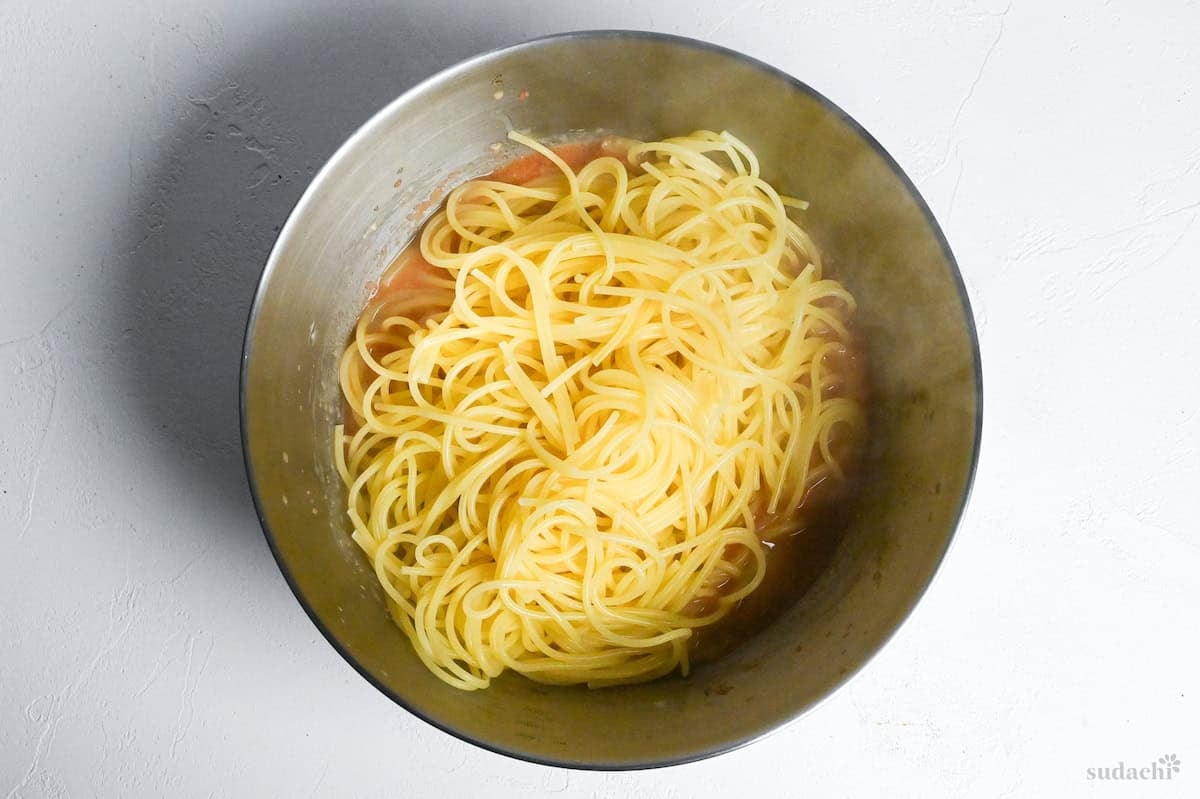
You can get exactly the right texture and consistency by adding pasta water in two stages.
The first addition helps start the emulsification process. The second addition lets you fine-tune the consistency to achieve that perfect glossy coating that clings to each strand.
Using tongs, toss everything together until every strand is coated in the creamy sauce. The residual heat from the pasta will gently warm the sauce.
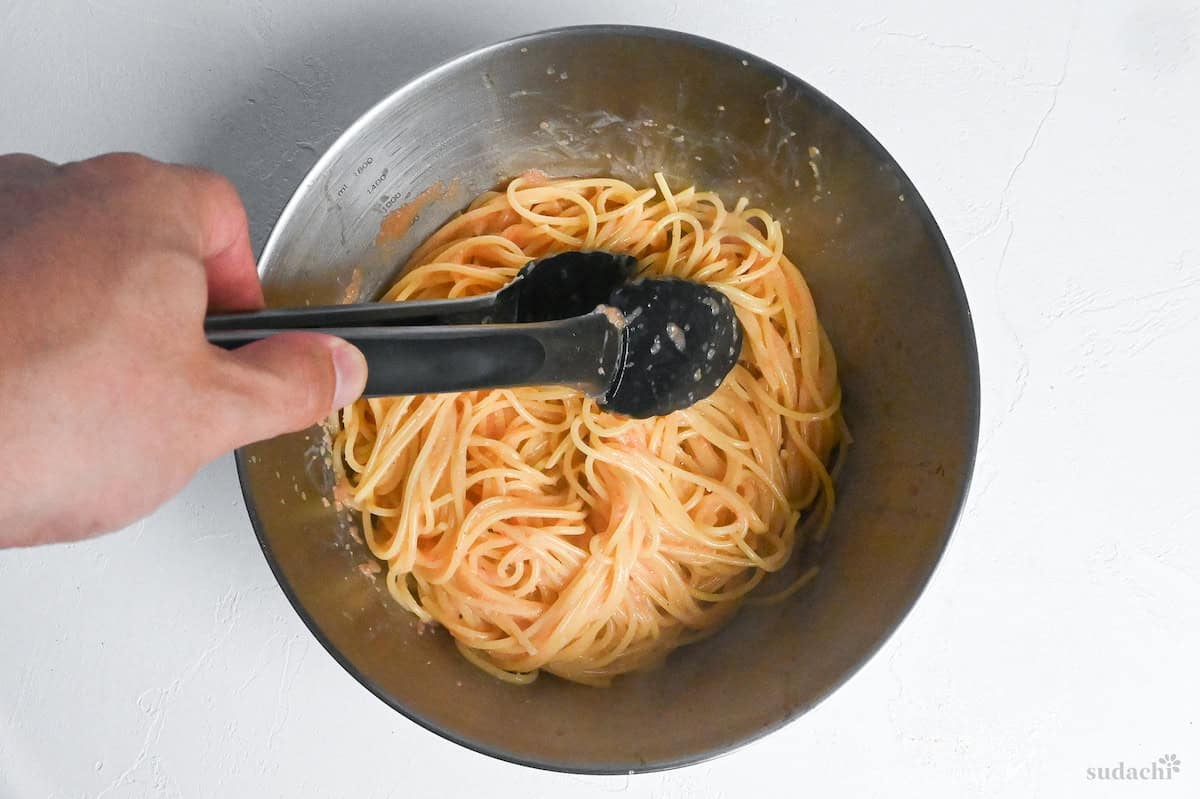
Transfer the pasta onto plates or shallow bowls, and finish with thinly sliced shiso leaves (or a sprinkle of shredded nori). Add an optional squeeze of fresh lemon juice and a sprinkle of lemon zest for brightness.
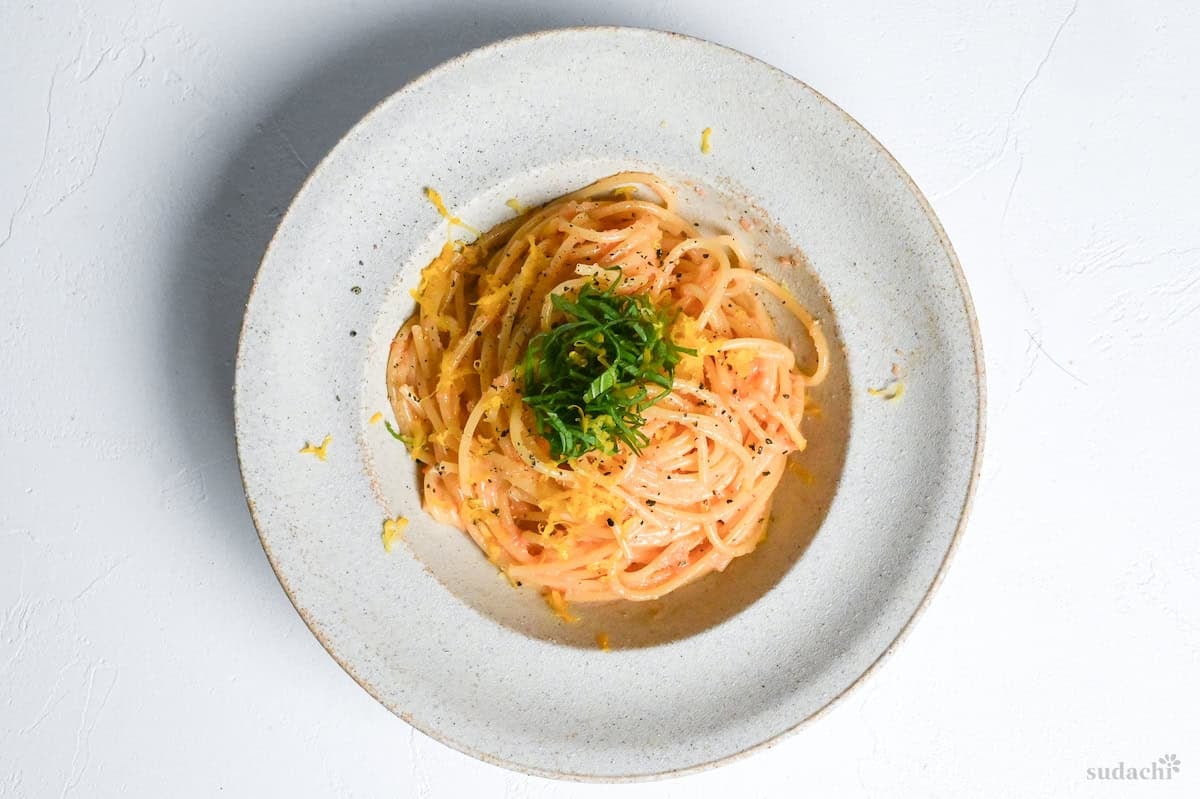
The citrus notes beautifully complement the richness of the sauce.
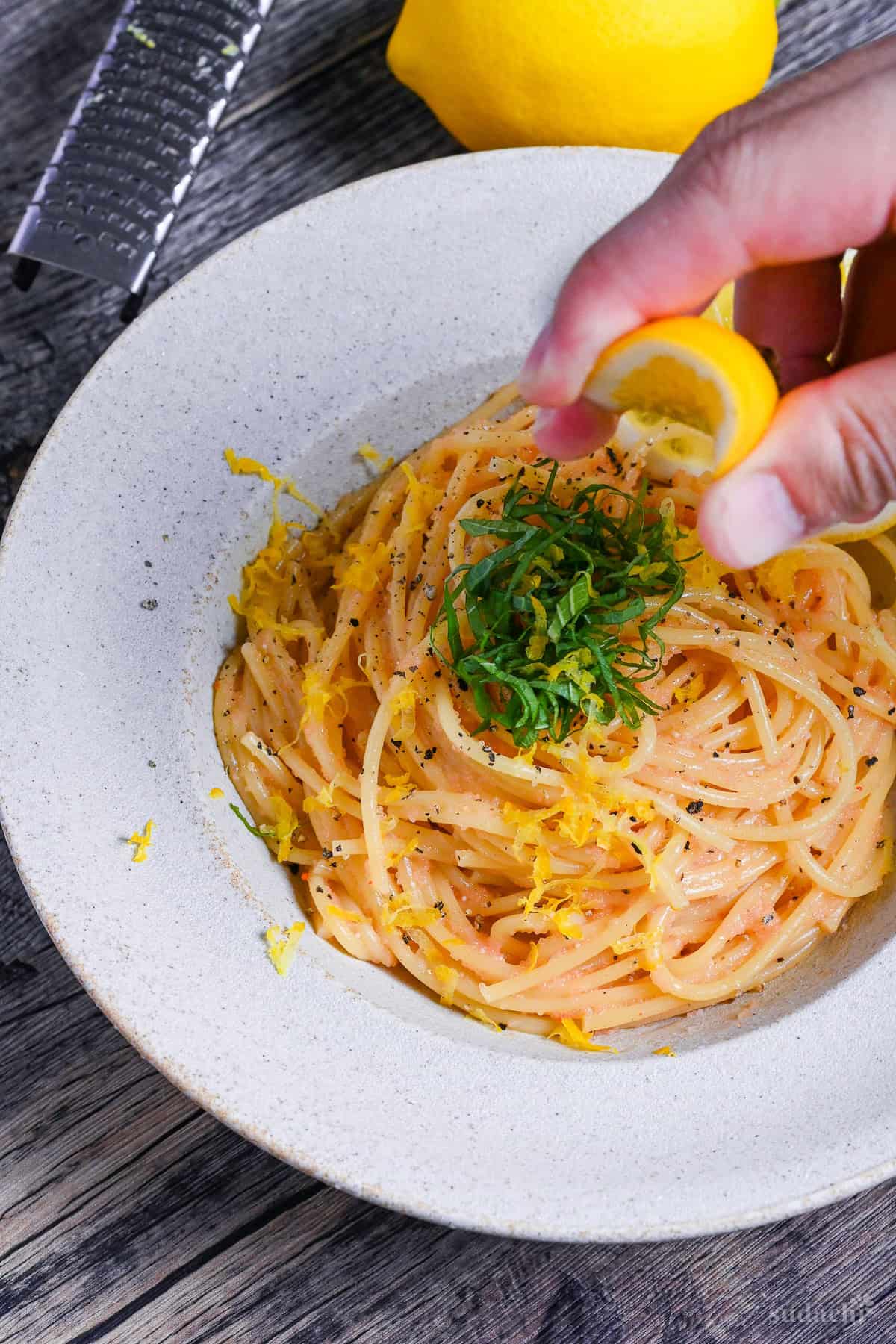

Essential Tips & Tricks
- Cook pasta slightly less than package instructions (about 30 seconds to 1 minute less) to ensure it stays firm and doesn’t become mushy after mixing.
- Emulsify your sauce by adding pasta water in two stages, whisking vigorously each time, to achieve a silky, well-integrated sauce.
- Combine pasta and sauce immediately after draining to avoid separation or greasy texture.
- If you’re sensitive to spice, swap spicy mentaiko for mild salted cod roe (tarako).
- Smoked paprika is my optional take but highly recommended! It adds subtle depth and a gourmet touch to your dish.
With these simple tips in mind, you’re set for success every time you make Mentaiko Pasta.
Meal Prep & Storage
Unfortunately, mentaiko pasta is not suitable for meal prep. The delicate mentaiko loses its signature texture and fresh flavor when stored, and the butter-based sauce separates when refrigerated, making it difficult to restore the original quality even with reheating.
As for storage, mentaiko pasta is best enjoyed fresh. If you have leftovers, let them cool, then put them in an airtight container and refrigerate them right away. Consume within 1 day.
Reheat carefully with a splash of water or milk in the microwave, avoiding overcooking, or gently warm in a pan on low heat with a little butter or water. Avoid reheating repeatedly, as quality diminishes rapidly.
Serving Suggestions
FAQ
Here are answers to frequently asked questions I have received across all platforms, including here, YouTube, Instagram, and Pinterest. If you have any questions, feel free to send them to me anytime! It will be a big help for everyone in this community!
Your sauce didn’t emulsify properly. To fix this, gradually add reserved pasta water while whisking vigorously, leaving the pasta slightly wet after draining to aid emulsification.
Overcooking pasta or allowing it to sit after draining leads to mushiness. Always cook pasta slightly shorter than the package instructions and mix it immediately into the sauce.
They are not going to produce the same result, but below are some alternative ideas:
1. Russian or Eastern European canned cod roe
2. Pressed cod roe
3. IKEA’s Kalles Cod Roe Paste
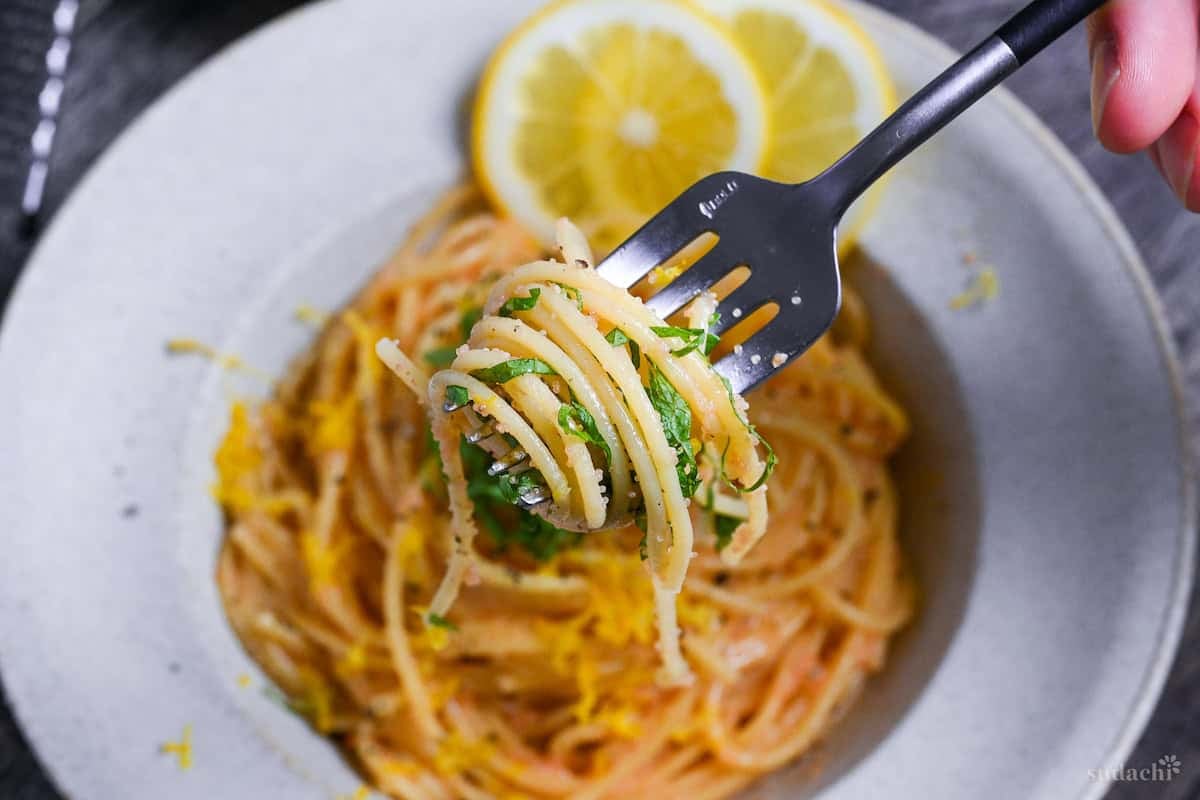
I hope you enjoy this Menatiko Pasta recipe! If you try it out, I’d really appreciate it if you could spare a moment to let me know what you thought by giving a review and star rating in the comments below. It’s also helpful to share any adjustments you made to the recipe with our other readers. Thank you!
More Wafu Pasta Recipes
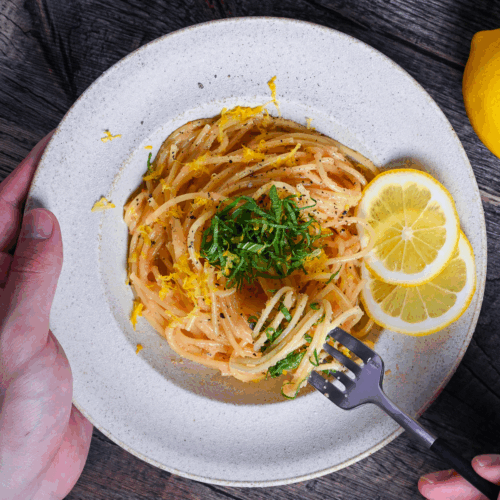
Mentaiko Pasta (Spicy Cod Roe Spaghetti Sauce)
Ingredients
- 200 g dry spaghetti 1.6-1.8mm thickness recommended
- 2000 ml water
- 1 tbsp salt
Sauce
- 80 g spicy cod roe (mentaiko) or plain tarako for non spicy option
- 20 g butter room temperature/soft
- 1 tbsp olive oil
- 1 tsp Japanese soy sauce (koikuchi shoyu)
- 1 pinch ground black pepper
- 1 tbsp whole milk
- 1 tsp grated parmesan cheese or other hard cheese
- ¼ tsp sugar
- ⅛ tsp smoked paprika powder optional, can omit
Toppings
- perilla leaves (shiso) shredded, or substitute with kizami nori
- lemon optional
- lemon zest optional
My recommended brands of ingredients and seasonings can be found in my Japanese pantry guide.
Can’t find certain Japanese ingredients? See my substitution guide here.
Instructions
- First, bring a pot of 2000 ml water to a boil. Once boiling, add 1 tbsp salt and 200 g dry spaghetti. Cook until "al dente" – firm to the bite. Generally this is 30 seconds to 1 minute less than the stated cooking time.

- Cut the membrane of 80 g spicy cod roe (mentaiko) and scrape out the roe using a spoon. (You can discard the leftover skin or eat it with rice.)

- Take a large mixing bowl and add the mentaiko, 20 g butter, 1 tbsp olive oil, 1 tsp Japanese soy sauce (koikuchi shoyu), 1 pinch ground black pepper, 1 tsp grated parmesan cheese¼ tsp sugar, ⅛ tsp smoked paprika powder and 1 tbsp whole milk.

- Add 1 tbsp of pasta water to the bowl of mentaiko sauce and mix thoroughly until smooth.

- When the pasta is almost done, add one more tbsp of pasta water to the sauce and whisk thoroughly. Drain the cooked pasta, add it to the bowl and mix until evenly covered.

- Divide the mentaiko pasta between serving plates. Top with shredded perilla leaves (shiso) or kizami nori, a squeeze of lemon juice and some lemon zest to taste. Enjoy!

Notes
- Cook pasta just before serving to prevent it from becoming sticky or mushy.
- If your sauce appears too thick or isn’t coating the pasta evenly, add more pasta cooking water one teaspoon at a time until you achieve a glossy, unified coating.
- Consume immediately for best results, but if you must store leftovers, refrigerate in an airtight container for 24 hours max and reheat gently with a splash of milk to restore creaminess.
- Serving ideas: Daikon Salad, Mugen Cabbage Salad, Corn Potage, Egg Drop Soup
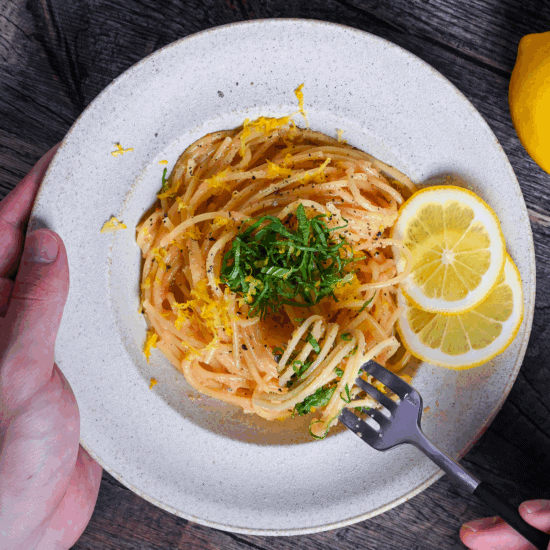


Leave a rating and a comment